
This is a list of fictional characters in the works of Charles Dickens .
Contents
Contents: A | B | C | D | E | F | G | H | I | J | K | L | M | N | O | P | Q | R | S | T | U | V | W | X | Y | Z |
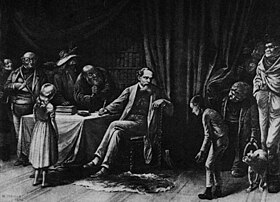

This is a list of fictional characters in the works of Charles Dickens .
Contents: A | B | C | D | E | F | G | H | I | J | K | L | M | N | O | P | Q | R | S | T | U | V | W | X | Y | Z |



"She was dressed in rich materials--satins, and lace, and silks--all white. Her shoes were white. And she had a long white veil dependent from her hair, and she had bridal flowers in her hair, but her hair was white...I saw that everything within my view which ought to be white, had been white long ago, and had lost its lustre, and was faded and yellow. I saw that the bride within the bridal dress had withered like the dress, and like the flowers, and had no brightness left but the brightness of her sunken eyes. I saw that the dress had been put upon the rounded figure of a young woman, and that the figure upon which it now hung loose, had shrunk to skin and bone. Once, I had been taken to see some ghastly wax-work at the Fair...Once, I had been taken to one of our old marsh churches to see a skeleton in the ashes of a rich dress, that had been dug out of a vault under the church pavement. Now, wax-work and skeleton seemed to have dark eyes that moved and looked at me. I should have cried out, if I could." [10]
Miss Havisham teaches Estella to deny any emotions which could leave her vulnerable to heartbreak and uses Pip for Estella to practice on. She wants to see Estella break men's hearts to avenge her own broken heart from being left at the altar by Compeyson years before. Pip mistakenly believes Miss Havisham intends him for Estella and is his secret benefactor as he goes to London and becomes a gentleman, finding out later that the convict Magwitch has supplied his 'Expectations'. Miss Havisham dies when her house burns down and leaves her fortune to Estella in Great Expectations .

Charles John Huffam Dickens was an English novelist and social critic who created some of the world's best-known fictional characters, and is regarded by many as the greatest novelist of the Victorian era. His works enjoyed unprecedented popularity during his lifetime and, by the 20th century, critics and scholars had recognised him as a literary genius. His novels and short stories are widely read today.
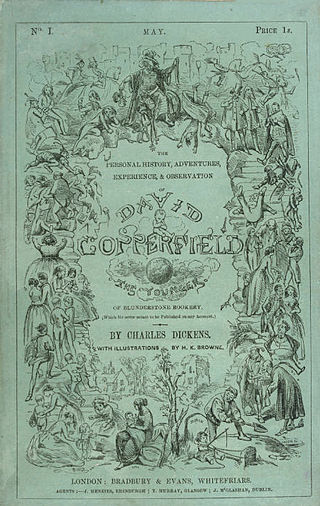
David Copperfield is a novel by Charles Dickens, narrated by the eponymous David Copperfield, detailing his adventures in his journey from infancy to maturity. As such, it is typically categorized in the bildungsroman genre. It was published as a serial in 1849 and 1850 and then as a book in 1850.
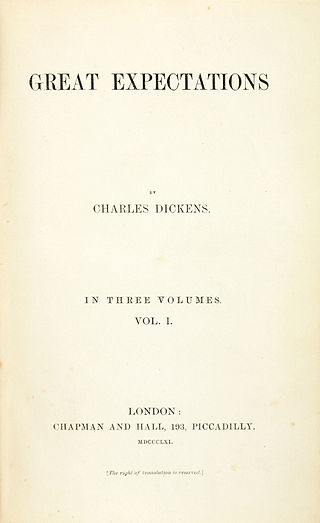
Great Expectations is the thirteenth novel by Charles Dickens and his penultimate completed novel. It depicts the education of an orphan nicknamed Pip. It is Dickens' second novel, after David Copperfield, to be fully narrated in the first person. The novel was first published as a serial in Dickens's weekly periodical All the Year Round, from 1 December 1860 to August 1861. In October 1861, Chapman & Hall published the novel in three volumes.

Bleak House is a novel by Charles Dickens, first published as a 20-episode serial between March 1852 and September 1853. The novel has many characters and several subplots, and is told partly by the novel's heroine, Esther Summerson, and partly by an omniscient narrator. At the centre of Bleak House is a long-running legal case in the Court of Chancery, Jarndyce and Jarndyce, which comes about because a testator has written several conflicting wills. In a preface to the 1853 first edition, Dickens said there were many actual precedents for his fictional case. One such was probably Thellusson v Woodford, in which a will read in 1797 was contested and not determined until 1859. Though many in the legal profession criticised Dickens's satire as exaggerated, Bleak House helped support a judicial reform movement that culminated in the enactment of legal reform in the 1870s.
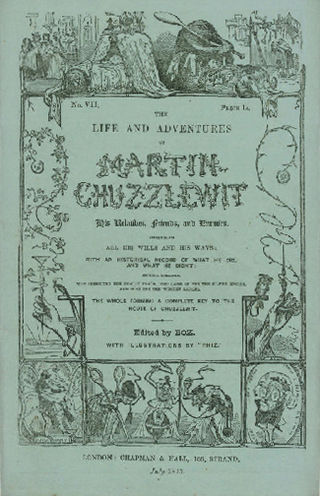
The Life and Adventures of Martin Chuzzlewit is a novel by Charles Dickens, considered the last of his picaresque novels. It was originally serialised between January 1843 and July 1844. While he was writing it Dickens told a friend that he thought it was his best work thus far, but it was one of his least popular novels, judged by sales of the monthly instalments. Characters in this novel gained fame, including Pecksniff and Mrs Gamp.

Nicholas Nickleby, or The Life and Adventures of Nicholas Nickleby, is the third novel by Charles Dickens, originally published as a serial from 1838 to 1839. The character of Nickleby is a young man who must support his mother and sister after his father dies.

Dombey and Son is a novel by English author Charles Dickens. It follows the fortunes of a shipping firm owner, who is frustrated at the lack of a son to follow him in his footsteps; he initially rejects his daughter's love before eventually becoming reconciled with her before his death.

Hablot Knight Browne was a British artist and illustrator. Well known by his pen name, Phiz, he illustrated books by Charles Dickens, Charles Lever, and Harrison Ainsworth.

Abel Magwitch is a major fictional character from Charles Dickens' 1861 novel Great Expectations.

Bleak House is a fifteen-part BBC television drama serial adaptation of the Charles Dickens novel of the same name, which was originally published in 1852–53 as itself a print serialisation over 20 months. Produced with an all-star cast, the serial was shown on BBC One from 27 October to 16 December 2005, and drew much critical and popular praise. It has been reported that the total cost of the production was in the region of £8 million.

Bleak House is a BBC television drama first broadcast in 1985. The serial was adapted by Arthur Hopcraft from the Charles Dickens novel Bleak House (1853).

Martin Chuzzlewit is a 1994 TV serial produced by the BBC, based on the 1844 novel by Charles Dickens, adapted by David Lodge and directed by Pedr James. The music was composed by Geoffrey Burgon.
The bibliography of Charles Dickens (1812–1870) includes more than a dozen major novels, many short stories, several plays, several non-fiction books, and individual essays and articles. Dickens's novels were serialized initially in weekly or monthly magazines, then reprinted in standard book formats.
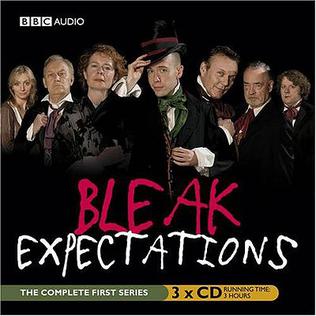
Bleak Expectations is a BBC Radio 4 comedy series that premiered in August 2007. It is a pastiche of the works of Charles Dickens, such as Bleak House and Great Expectations, from which it derives its name, as well as adventure, science fiction, and costume dramas set in the same period. Bleak Expectations parodies several of their plot devices whilst simultaneously tending toward a surreal humor along the lines of The Goon Show. The series has also demonstrated a fondness for allusions to and parodies of the films of Alec Guinness, particularly the Edwardian satire Kind Hearts and Coronets.
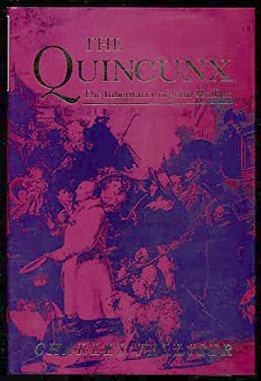
The Quincunx (The Inheritance of John Huffam) is the epic first novel of Charles Palliser. It takes the form of a Dickensian mystery set in early 19th century England, but Palliser has added the modern attributes of an ambiguous plot and unreliable narrators. Many of the puzzles that are apparently solved in the story have an alternative solution in the subtext.
Bleak House is the first BBC adaptation of Charles Dickens' 1853 novel of the same name. It was adapted by Constance Cox as an eleven-part series of half-hour episodes first transmitted from 16 October 1959. Unlike most television series of the 1950s, the complete serial survived and, in 2017, was released to DVD by Simply Media.

Esther Summerson is a character in Bleak House, an 1853 novel by Charles Dickens. She also serves as one of the novel's two narrators; half the book is written from her perspective. It is the only example of a double narrative in Dickens and the first person female voice may have been influenced by the example of Charlotte Brontë's Jane Eyre, published in 1847.
The Bleak Old Shop of Stuff is a four-part comedy series produced by BBC, which premiered on BBC Two on 19 December 2011. It is a parody of the works of Charles Dickens, drawing its title from Bleak House and The Old Curiosity Shop. It is a television successor to Bleak Expectations, a radio parody of Dickens which began in 2007, and with which it shares the writer Mark Evans, producer Gareth Edwards and actor Richard Johnson; while not a direct adaptation it shares the same style, atmosphere and sense of humour. It is directed by Ben Gosling Fuller, who also directed the show That Mitchell and Webb Look.

Dickensian is a British drama television series that premiered on BBC One from 26 December 2015 to 21 February 2016. The 20-part series, created and co-written by Tony Jordan, brings characters from many Charles Dickens novels together in one Victorian London neighbourhood, as Inspector Bucket investigates the murder of Ebenezer Scrooge's partner Jacob Marley.
Campbell Logan (1910–1978) was a British television producer and director. He produced a large number of serials for the BBC, often based on classic works of literature.